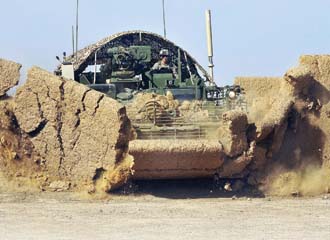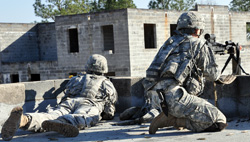Army Mobile Network Poised for Combat
 |
A U.S. Stryker Brigade destroys an abandoned compound in Hutal, Afghanistan. The Army soon will begin fielding a fully integrated mobile network capability to brigade combat teams |
In the coming months, the U.S. Army will begin fielding components of its first integrated mobile network to units headed to Afghanistan. The equipment package known as Capability Set 13 will provide integrated voice and data throughout the brigade combat team. It also will offer on-the-move and beyond-line-of-sight communications, which could transform combat operations.
Capability Set (CS) 13 is a key part of the Army’s overall brigade combat team modernization plan, which includes new vehicles, network components and associated equipment and software. CS 13 components include the Warfighter Information Network–Tactical (WIN-T) Increment 2, which is sometimes informally referred to as WIN-T 2; the Harris AN/PRC-117G radio; the Joint Tactical Radio System Rifleman Radio; and the Joint Capabilities Release, which is the next-generation force tracking software. CS 13 is essentially an entire mobile network being fielded in one fell swoop rather than as individual pieces over a number of years.
Service leaders already have selected several brigade combat teams to receive the equipment, and they are beginning with units destined for deployment to Afghanistan. “Our target is to begin fielding a few brigades starting in fiscal year 13, after the first of October. Those units have been identified and notified. We are targeting units that are deploying,” says Paul Wilson, the Army’s project director for synchronized fielding in the System of Systems Integration Directorate. “WIN-T 2 is going through operational test and evaluation in early summer. Out of that, we’ll get a fielding decision.”
Most of the components already have been fielded on a smaller scale to Afghanistan, and reports have been positive, according to Army officials. They also have been assessed thoroughly through a series of Network Integration Evaluation (NIE) exercises. “We’re pretty satisfied that everything works. Our goal is to give the soldiers the best stuff we’ve got if they’re going into harm’s way,” Wilson says.
Approximately every two years, another capability package will be fielded, keeping the network as modernized as the service can manage. “The advantage of the integrated network for Capability Set 13 is that—and it’s really the first time we’ve ever done it like this—instead of fielding and training and deploying individual systems, we are endeavoring to integrate those on a targeted platform for a targeted mission for a targeted set of soldiers,” says Maj. Bill Venable, USA, assistant program manager, System of Systems Integration Directorate. “You get a fully compatible, functional network that will go end to end, from the rifleman all the way up to the brigade combat team commander.”
Maj. Venable explains that CS 13 is an evolutionary process with potentially revolutionary results. “Some of the capabilities within it are revolutionary, in my opinion, especially Win-T Increment 2,” he says.
Part of the revolutionary capability will be in disseminating information much more rapidly, enabling faster decision making and providing commanders more time to plan and execute missions. Traditionally, sharing information on the battlefield depends on a series of face-to-face meetings. For example, to receive mission orders known as target packages, company commanders drive to the battalion tactical operations center to meet with the battalion commander or operations officer. Those company commanders then drive back to their units and meet with their platoon leaders. Those platoon leaders, in turn, meet with their squad leaders, who pass along the information to the individual soldiers in their squads.
Maj. Venable, who commanded an infantry company in Iraq, describes the process. “The time it took me to go to battalion headquarters, have the mission explained to me, drive back and relay that information sometimes was an hour and a half sometimes,” Maj. Venable says. “With Capability Set 13, I can download the document right now and be on a conference call from a vehicle reviewing that document within two minutes of its release.”
Traditional communication also relies on line-of-sight radio communications, which have limitations—namely distances and obstacles, such as mountain ranges that interfere with the radio signals. And those limitations can have serious consequences on the battlefield. “I conducted a mission in Iraq about 40 miles outside my battalion zone, and I lost radio contact,” Maj. Venable reports. “The situation started going south, and I had to withdraw my troops because I could not communicate to call for medevac or for support, if I needed to.”
 |
Paratroopers from the 3rd Brigade Combat Team, 82nd Airborne Division, carry Joint Tactical Radio System devices during a field exercise at Fort Bragg, North Carolina. The Joint Tactical Radio System Rifleman Radio will be fielded with brigade combat teams headed to Afghanistan as part of Capability Set 13. |
“It reduces confusion on the battlefield. It reduces operational risk. You don’t have to put vehicles on the road and risk getting ambushed or hit by an improvised explosive device. It potentially has a logistics impact because we’re driving vehicles around less often. There are some pretty powerful effects with regard to fielding this capability,” Maj. Venable asserts.
One of those effects will be on command and control. During an integration exercise three years ago, the Army deployed a company to the mountains of New Mexico while keeping the command post at Aberdeen Proving Ground, Maryland. “We received reports and commanded that company from this location over WIN-T Increment 2. It’s pretty powerful,” Wilson says. “From the command and control perspective—without regard to logistics—you can deploy a regular force unit, such as an infantry company, anywhere on the planet and guide it from great distances.”
WIN-T 2, the heart of the Army’s modernized network, is a self-healing, on-the-move, high-speed, high-capacity backbone communications network, linking warfighters on the battlefield with the Global Information Grid (see page 29). The terrestrial radios serve as the primary connection; satellite communications radios provide connectivity when the line-of-sight radios fail. WIN-T 2 includes command posts with tactical control nodes and vehicle wireless packages that will provide a wireless network “very much like the Wi-Fi at Starbucks, but secured for our purposes,” Wilson explains.
In May, WIN-T 2 headed into its initial operational test and evaluation, its largest operational test to date. The test was held primarily at White Sands Missile Range, New Mexico, as part of the NIE 12.2. The three-week test is designed to assess WIN-T 2’s survivability and effectiveness with an operational unit. Also in May, the Army completed the network design, which will evolve for future capability sets based on technology advances and changing operational needs.
In addition to WIN-T Increment 2, the Army is deploying a second beyond-line-of-sight backbone—the Force XXI Battle Command Brigade and Below (FBCB2) Joint Capabilities Release (JCR). FBCB2 JCR is a networked battle command information system that enables units to share near-real-time friendly and enemy situational awareness information, operational maps and graphics, and command and control messages. Because it was developed jointly with the Marine Corps, the JCR also is better equipped than previous FBCB2 iterations for joint operations, Army officials say.
The Army’s modernization is a herculean effort. It involves thousands of soldiers participating in a series of NIEs, warfighters in the combat zone, nearly every program executive officer and program manager in the Army, research and development centers and the test community. “It’s a constant battle to make sure we’ve checked all of the details and all of the players so that we have everything aligned. It takes constant coordination and constant meeting. There are thousands and thousands of tasks that have to be aligned,” Wilson says.
CS 13 also is being coordinated with other modernization programs of record, including both the Joint Light Tactical Vehicle, a Humvee replacement, and the Ground Combat Vehicle, the new armored vehicle for heavy and Stryker brigade combat teams. Both will serve as platforms for the vehicle-mounted CS 13 components. Army officials emphasize that coordinating the various pieces of the modernization puzzle will save both time and money. For example, officials will not discover late in the process that the communications equipment is too big for the vehicles, which would require some re-engineering, causing delays and increasing costs. “This is an enduring mission for the Army in modernizing and getting this equipment out to the soldier as quickly as we can,” says Elizabeth Miller, chief engineer, synchronized fielding, System of Systems Integration Directorate. “That is something that has needed to be improved within the acquisition community—to be more forward-looking and reduce costs and get fieldings done in a timely manner.”
It is the coordination effort, rather than the technology development, that continues to challenge Army officials. “The challenges are in aligning platforms and units and deployment times. With the technical piece, we have a path that we want to get to the end of, and we’re probably at the 90 percent solution on that side of it. The other side is a Rubik’s Cube of issues with regard to getting the units involved and getting the acquisition processes, such as contracting, aligned with the deployment windows,” Maj. Venable says. “But this capability will get fielded.”
WEB RESOURCES
Capability Set 13: www.army.mil/article/74399/
Network Integration Evaluation: www.bctmod.army.mil/nie_focus/index.html




Comments